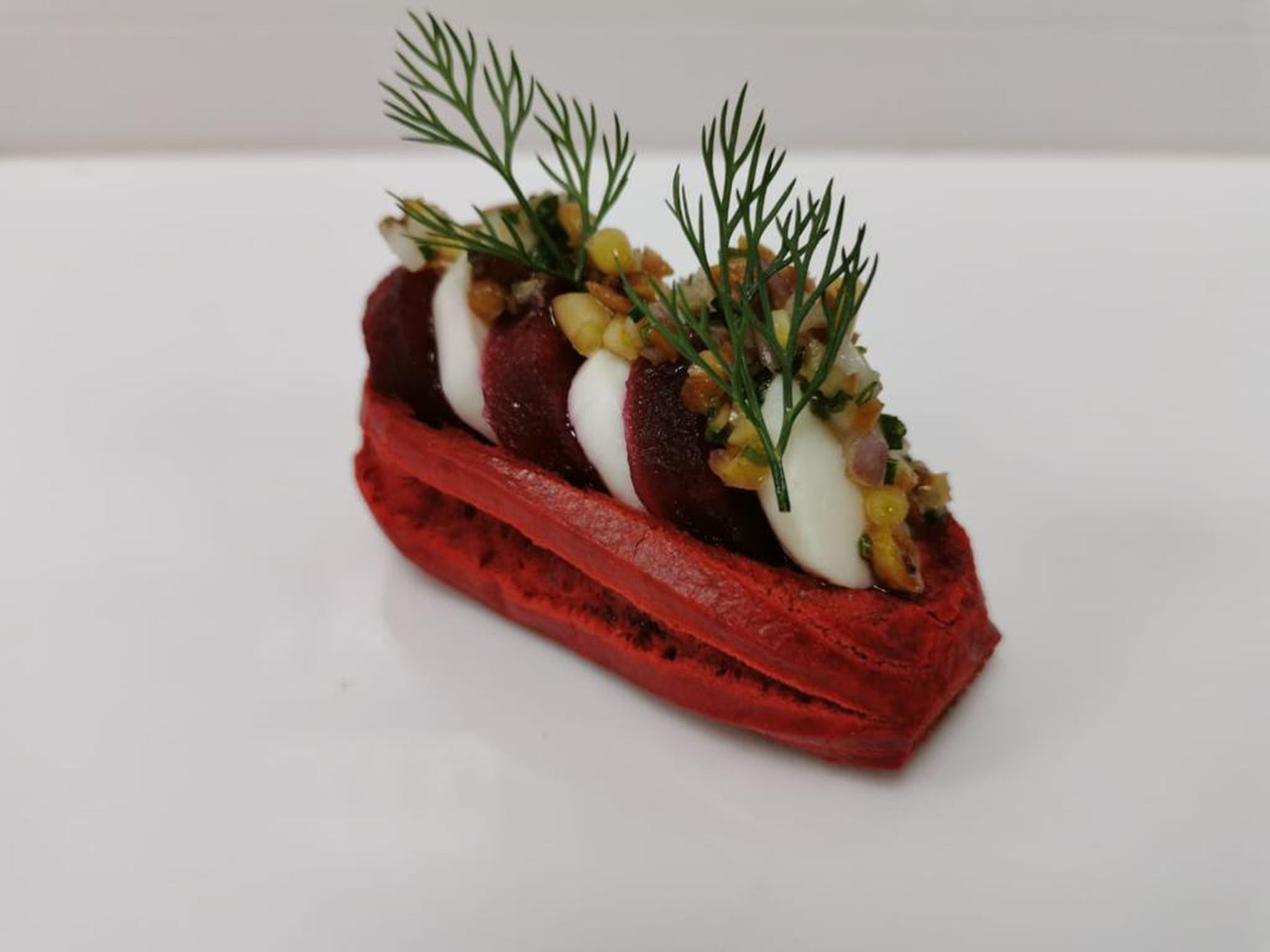
Beetroot and dill eclairs at Gatsby.
Credit: Special Arrangement
On a breezy Sunday morning, we walked into one of the new experiential cafés in the city — Kana by Coffee Mechanics, and I ordered an extremely interesting Turkish dish called Cilbir. Fluffy poached eggs with chilli butter, parsley oil, dill yoghurt and sourdough toast, the delicious offering had me swooning over the distinct flavour of dill more than anything. So much so that I bought a bunch soon after and started sprinkling the leaves generously in anything and everything I prepared, much to the chagrin of my family! Be it upma or dosa, idli or even toast, the delicate and fragrant dill became a fixture in every dish I prepared over the next few days.
A realisation too gradually dawned upon me — that it’s not just me who is rediscovering these leaves that bring back some distant memories of childhood — of crunchy dill masala vadas and flavourful dill sambar that my mother used to prepare. The slightly pungent yet supremely aromatic sabbaki soppu is also catching the fancy of many home cooks and modern restaurants.
Ganga Prabhakar, co-founder and director of the quaint café Kana which restarted my love affair with the perfumed herb, says that one can either love the leaves or hate them. Hence, they need to be used carefully. “As a café, we are cuisine agnostic but flavour forward — we like to use local ingredients in unfamiliar ways,” she says. “We also believe in serving a portion of greens to balance the nutritional element of a dish, more so, if they are locally sourced. So you would find dill in a lot of our dishes — from pizzas to garlic bread and even puffs and the smoked ham toast,” she adds.
From native to upmarket
A constant part of Indian cooking, more so in Karnataka cuisine, where it’s added to dosa, idli, masala vada and akki roti, it was just a matter of time before the humble soppu started to frequent the menus of high-end restaurants too — to not just lift the taste of the food a notch higher but also increase its nutritive value. Chef Aditya Das, Director of Culinary Arts, Gatsby Cocktails and Cuisine, a popular restobar in the city, thoroughly enjoys cooking with dill with his main focus being retaining its nutritional value.
Perfect as a flavouring agent
“It’s a known fact that the more a vegetable is cooked, the more its nutrients decrease. The same holds true for greens. But in the case of dill, you don’t have to cook it. Hence, it works perfectly well with cold cuisines like cold soups, salads and fermented foods,” he says and adds, “I particularly like using it with salt and sugar to cure salmon as dill is a great flavouring agent for any fish-based dish. The pairing of fish and dill is an ideal one, similar to the one of red meat, asparagus and baby carrots.” Some chefs like to tap into the flavour of the dill to balance a dish out. Says Souvik Banerjee, Executive Sou Chef of Long Boat Brewing Co., a brewery, “In nuchinunde (steamed dal dumplings), we use dill leaves to tone down the rawness of toor and moong dal while infusing a unique taste in the dish. For our cilantro-crusted fish, dill leaves are incorporated to diminish the fishy smell and lend an aromatic note to the sauce, resulting in a harmonious dish. In grilled prawns in chilli beans sauce, dill leaves play a crucial role in mitigating the strong seafood essence of tiger prawns. Their addition helps mellow down the overpowering aroma of the dish, thereby ensuring a more enjoyable dining experience for the guests.”
Home chefs too enjoy creating a host of dishes with the piquant herb. Karen Martin, a publicist who runs a kitchen called House of Anglo, opts to work with dill leaves whenever a dish is heavy and dairy-based. “Dill adds a lot of flavour to a cheesy or creamy gravy and lightens it up. Pairing it up with lentils and pulses also helps in easy digestion. That’s why it works very well in bite-sized items like falafels and masala vadas, which could be heavy on the palate otherwise.” She adds, “Even as a garnish, it makes any dish look beautiful. I especially love using dill leaves with flowers on my dishes, whether it’s a steak or panna cotta.”
With its nutritive value and distinct aroma, dill for sure has begun its journey to fame, and will soon probably be on the same pedestal as its international cousins — celery and parsley. But as far as my culinary experiments are concerned, a dash of it here and a sprinkle there totally works!